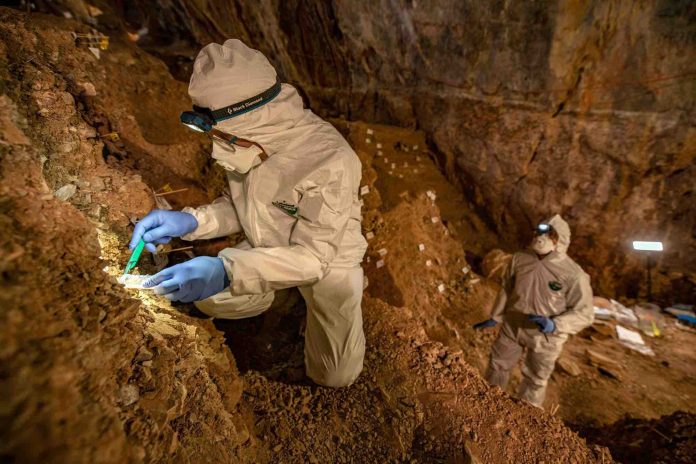People travelled by boat to North America some 30,000 years ago, at a time when giant animals still roamed the continent and long before it was thought the earliest arrivals had made the crossing from Asia, archaeological research reveals today.
Researchers from the University of Oxford have published a study, showing important new insights into our understanding of these ‘First Americans’, who made the journey from eastern Eurasia before the last Ice Age. And it reveals that the arrival of humans in numbers coincided with the ‘catastrophic decline’ in now-extinct large animals, including camels, horses and mammoths.
Based on a powerful statistical approach, the international team, led by Oxford’s Professor Tom Higham, Director of the Oxford Radiocarbon Accelerator Unit, School of Archaeology, was able to build a chronological framework for the arrival of humans into North America – and their dispersal across the continent.
This showed that people were present long before previous estimates – before, during and after the ‘Last Glacial Maximum’, the peak of the Ice Age, when temperatures fell to their lowest for tens of thousands of years. But, the research, also shows that they must have come by sea, rather than across a land bridge.
According to Professor Higham, ‘A combination of new excavations and cutting-edge archaeological science is allowing us to uncover a new story of the colonisation of the Americas. The First Americans came from eastern Eurasia, and it looks as though there was a surprisingly-early movement of people into the continent.
‘The people that travelled into these new lands must have come by boat, because the northern parts of North America were impenetrable and sealed off from eastern Eurasia by a massive ice sheet until 13,000 years ago.
‘The discovery that people were here more than 30,000 years ago raises a range of key new questions about who these people were, how they lived, how widespread they were and, ultimately, what their fate was.’
In addition, when the timeline for humans was compared with dates obtained for extinct animals, the analysis showed human expansion, during this warmer period, happened at broadly the same time as their disappearance. The team suggests an increase in human population seems to be linked to a significant impact on the catastrophic decline of these large megafauna.
One of the team, Dr Lorena Becerra-Valdivia (now with the University of New South Wales), says, ‘The peopling of the Americas was a complex and dynamic process…What is clear is that humans were present in the continent well before previously accepted dates. But it was only around 14,700 years ago that those people became more highly visible in the archaeological record, likely due to an increase in population.’
Alongside this research, another team, led by Dr Ciprian Ardelean, from the University of Zacatecas, Mexico, and the University of Exeter, has disclosed the results of a decade of excavation of a high-altitude cave in Chiquihite, central Mexico. The cave has shown occupation earlier than anything previously known and, according to Dr Ardelean, ‘It seems likely to us that the people of Chiquihuite represent a ‘failed colonization’, one which may well have left no genetically detectable heritage in today’s First Americans’ populations.’
Dr Jean-Luc Schwenniger, who heads Oxford’s Luminescence Dating Laboratory at the School of Archaeology, notes, ‘Our involvement in the dating of this extraordinary site stretches back almost ten years and finally to see the results published is immensely satisfying…the publication of these new discoveries and findings, which rock and challenge long established views, required extra amounts of diligence, scrutiny, patience and perseverance.’
The Oxford results are based on hundreds of dates obtained from 42 archaeological sites in North America and Beringia (the ancient land bridge connecting the continent to Asia). The team used a statistical approach known as Bayesian age modelling performed on software (OxCal) developed in Oxford by Professor Christopher Bronk Ramsey. The analysis estimates the start of human occupation at different sites, as well as the commencement of three distinct stone tool traditions in these regions. Dates were combined statistically along with stratigraphic information from the deposits to estimate the start and end of human occupation at each of the sites and then plotted spatially across the continent. The Oxford work was funded by the Natural Environment Research Council (NERC; grant NF/2017/1/2), Merton College, Santander, and the Clarendon Fund. The latter also provided the funding for the paper titled, “The timing and impact of the earliest human arrivals in North America”.















